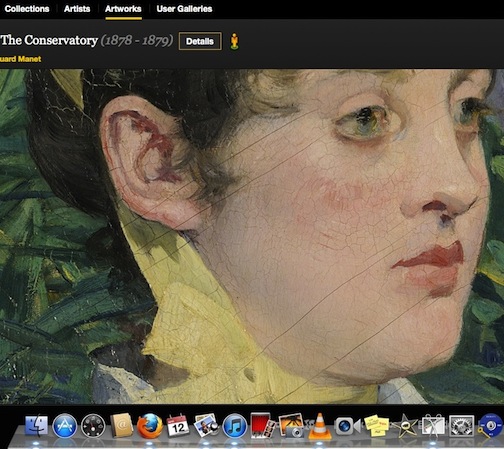Google, bring me everyone
I’d forgotten the Google Art Project existed until I read Roberta Smith’s celebration of it in the NYTimes just now, on-line. It has expanded considerably since last year, and though I don’t think this is going to suck as many hours out of my life as Halo has, over the years, it could be a contender. It’s frustrating to read how resistant many museums and rights-holders continue to be, given the potential for total access this project could offer to nearly anything and everything ever painted–and what a gift that would be to nearly anyone interested in art. Painting is meant to be seen, not stored away in private rooms. The sad reality of art, in general, is that the public has access to only the tiniest tip of the iceberg. Of work that’s been done over the centuries, the vast majority sits in vaults or in places only few can access–it’s as good as gone, a sea of unreachable, unknowable dark matter for most of us. Those rights-holders who continue to stand aloof from the Google project should bear in mind that there continues to be no substitute for actually standing a few feet away from a work of art: no reproduction can fully capture what you see by looking at the living, physical object. I spent years scratching my head over Bonnard’s critical standing until I turned a corner at MoMA and stood before one of his surfaces, astonished. And I’ve also felt deflated looking at work that thrilled me in books or on the web, only to see how clumsily the painter actually handled the medium. Yet if my quick sample of Google’s project is any indication of its potential, it could come pretty close to the experience of seeing the actual work, and this would be an enormous boon to both artists and scholars. When I went to this site this morning, I clicked on the first image that appeared, Manet’s In the Conservatory, and double-clicked to zoom a little closer. Then I did it again, expecting blur or those squiggles of photographic compression. Yet the image stayed crisp. Again, I clicked, with no loss of resolution. By the time I was done, I was as close as a kiss to this lovely model’s face. Nothing but her cheek and lips filled the screen–a pleasant prospect in and of itself, but it also showed me the actual surface of the canvas so distinctly I could make out how the thing had been rolled for storage. The diagonal cracks in the oil paint clearly showed that someone had removed it from the stretcher and rolled it, starting with the point of one corner and ending at the opposite one. I don’t especially need this information, but someone else might, and yet what I do want is to see the quality of his paint, the perfect, delicate skin tone, the evidence, yet again, of Manet’s seemingly cavalier brushwork, all the effortless mastery so clearly there in every square inch of his best work. So bring it on, Google. Get it all on-line. Everything. Picasso! Braque! Artists I’ve never heard of. Right now, I am Gary Oldman in The Professional, crazed and, well, frankly a little goofy with bloodlust, telling his henchman: Bring me everyone.
Whataya mean everyone?
Oldman roars: EVERYONE!

I just read this NYT article last night. I’d forgotten about the Google Art Project, I need to check it out. I’ve time and time again been frustrated by visiting a museum, loving a painting, not finding a postcard in the gift shop, not finding an image online. I like to be able to stick a postcard on my studio wall when I find something that moves me. I look forward to it’s expansion.
Have you seen artrenewal.org? – they can be annoying in their worship of classical realist works, and their taste for Alma-Tadema, Bouguereau etc is saccharine to the point of throwing up, but they have a TON of images, many high resolution (not as high as Google Art Project though).